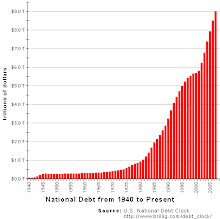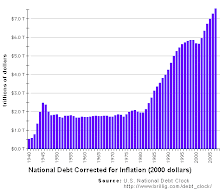Saturday, June 7, 2008
The Rule of 70
The rule of 70 is a way to approximate the relationship between present and future values. The rule of 70 states that if a variable grows at a rate of x percent per year, then that variable doubles in approximately 70/x years.
x 70/x Application of the rule of 70
to the rate of return on personal investments
1 70 If an investment earns a rate of return of 1% per year, then the value of the investment will double in approximately 70 years.
2 35 If an investment earns a rate of return of 2% per year, then the value of the investment will double in approximately 35 years.
3 23.33 If an investment earns a rate of return of 3% per year, then the value of the investment will double in approximately 23 years.
4 17.5 If an investment earns a rate of return of 4% per year, then the value of the investment will double in approximately 17 years.
5 14 If an investment earns a rate of return of 5% per year, then the value of the investment will double in approximately 14 years.
6 11.67 If an investment earns a rate of return of 6% per year, then the value of the investment will double in approximately 12 years.
7 10 If an investment earns a rate of return of 7% per year, then the value of the investment will double in approximately 10 years.
8 8.75 If an investment earns a rate of return of 8% per year, then the value of the investment will double in approximately 9 years.
9 7.78 If an investment earns a rate of return of 9% per year, then the value of the investment will double in approximately 8 years.
10 7 If an investment earns a rate of return of 10% per year, then the value of the investment will double in approximately 7 years.
Table 2. Examples of using the rule of 70.
x 70/x Application of the rule of 70
to the rate of return on personal investments
1 70 If an investment earns a rate of return of 1% per year, then the value of the investment will double in approximately 70 years.
2 35 If an investment earns a rate of return of 2% per year, then the value of the investment will double in approximately 35 years.
3 23.33 If an investment earns a rate of return of 3% per year, then the value of the investment will double in approximately 23 years.
4 17.5 If an investment earns a rate of return of 4% per year, then the value of the investment will double in approximately 17 years.
5 14 If an investment earns a rate of return of 5% per year, then the value of the investment will double in approximately 14 years.
6 11.67 If an investment earns a rate of return of 6% per year, then the value of the investment will double in approximately 12 years.
7 10 If an investment earns a rate of return of 7% per year, then the value of the investment will double in approximately 10 years.
8 8.75 If an investment earns a rate of return of 8% per year, then the value of the investment will double in approximately 9 years.
9 7.78 If an investment earns a rate of return of 9% per year, then the value of the investment will double in approximately 8 years.
10 7 If an investment earns a rate of return of 10% per year, then the value of the investment will double in approximately 7 years.
Table 2. Examples of using the rule of 70.
Subscribe to:
Post Comments (Atom)






The rule of seventy makes it easy to figure investment returns almost instantly.
ReplyDelete